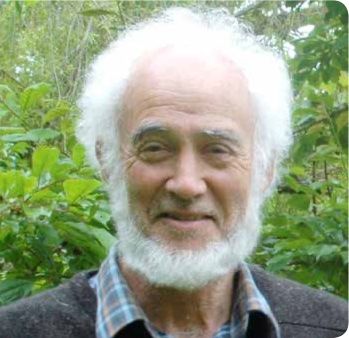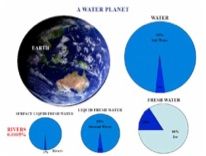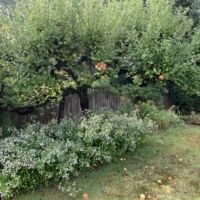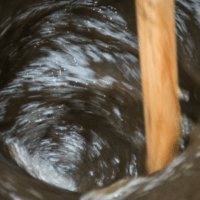The Nature of Liquid Water – Gary Williams
Harvest Article – Spring 2017
Gary Williams – philosopher, professional soil and water engineer, permaculture consultant and teacher, and biodynamic farmer – offered a fascinating presentation at the 2017 conference that drew on his diverse experiences and wove together many intricate ideas. He summarises that talk here.

Water plays such an important role in physical and living processes that its flow patterns and influences are fundamental to our life experiences.
At the same time, our understanding of water and its flow patterns, and our relationships with water, depend on our worldview. A worldview is the cultural framework we use to understand our experiences and the world around us; it conditions our view of reality and how things happen.
There are as many worldviews as there are cultures, communities and people in the world. However, there is an interesting duality in our cultural worldview, as expressed in the question of quantum mechanics: ‘Is it a particle or a wave?’ Is it a moving object or is it an energy field?
You can see the world in terms of material objects or interacting energies, as substance or ethers. Matter and energy are equivalent, and Albert Einstein gave us a quantitative relationship in terms of the speed of light. Matter is just slow-moving energy, while energy is fast- moving matter. An event is a fast-moving object, and an object is a slow-moving event!
The flow patterns of liquid water provide a bridge between these matter and energy viewpoints. These patterns look like energy fields in terms of their wavelike forms, but are formed by the movement of the water. The wave pattern reflects the interaction of the flowing water with its surroundings; the wave is an ‘interference pattern’ that is retained while the mass of the water keeps flowing through. A simple wave pattern shows itself in the standing wave upstream of a boulder in a stream bed, or in the ‘humps and hollows’ where waves from different directions move through each other. Moving water sets up energy fields through the interconnectedness of its streamlines, which can enfold into more and more complex patterns.
Water patterns
The basic movement of liquid water is the vortex – a spiralling inwards and outwards flow which is connected to the surrounding flow. This movement form is everywhere, from the intertwining strands of DNA to the interactions of galaxies. The ability of a body of water to develop vortices is a measure of its energetic vitality; the more complex the expression, the more alive and engaging is the water.
“Matter is just slow-moving energy, while energy is fast-moving matter. “
The movement of water, as with life, goes through transitions, where the characteristics of the form change suddenly, as a step-change. The forms and step-changes are repeatable, depending on the speed and containment of the flowing water. Recognising these patterns provides information on the characteristic behaviour and health of an entity or being.
Water and life
Water is the facilitator of life. All the exchanges of life require the presence of water. Life can be understood as a synergy between the movement patterns of water and the multiple- bonding ability of carbon, which can form very long and complex chains and rings, with a wide array of elements attached.
Water’s ability to facilitate the organic processes of life arises from weak bonds that form between water molecules. These weak bonds occur between a hydrogen (H) atom of a water molecule and an oxygen (O) atom of a different water molecule. These weak bonds between water molecules give rise to all of water’s behavioural anomalies, which in turn allow it to act as the foundation and facilitator of life.
The weak bonds allow clustering or shells of water to form around other molecules, and thus dissolve them within a body of water. Water is the universal solvent. It is only the very long and complex enfolded molecules of fats or oils that water cannot so easily encircle and isolate.
Water’s solid form, ice, is less dense than liquid water, because the weak bonds maintain a less dense structural form than flowing water. Breaking up these weak bonds necessitates the high energy requirements needed to melt or evaporate water. This high heating requirement gives rise to water’s heat-transferring and moderating effects, which is what water does in the atmosphere. Our weather arises from the transferring of heat around the globe, principally by water.
Water is most dense at 4° C. The blood temperature of 37.5° C is the point of lowest heat requirement or specific heat of water. These are critical temperatures for life and the exchange of nutrients.
If the container fits the flow pattern, then water moves with ease. In natural systems, there is an interplay between the flow and its containment, seeking a dynamic balance. The landscape and its waterways form each other; in the same way, the circulation of blood in the body and the blood vessel system will have a natural accommodation and balance.
Heart – a pump, or pumped?
One of the three things that Rudolf Steiner said stood in the way of the proper development of humanity was “people thinking that the heart is a pump.” Is the heart a pump forcing the blood through the body to all its cells, or is blood flow controlled by the cell membranes, with the heart being a regulator that is ‘pumped’ by the blood flowing through it? The blood pressure and flow can be measured, and the maths are the same, whether the heart pumps or is pumped.
Viktor Schauberger, another central European thinker and activist educator, believed in the existence of implosive contracting energy as well as explosive expansionary energy. He believed that the culture and development approach in Europe had been far too expansionary – hence the destructive impacts on landscapes and waterways. He was a close observer of water and the life it supports, and one of the many things he demonstrated about water was the importance of temperature and containment shape.
For example, experiments at a technical institute in Stuttgart showed that a spiralling pipe with an appropriate helical shape could pass water with no energy expenditure for specific flows, and that there is a harmonic set of such flows. This is, of course, completely contrary to conventional theories of fluid mechanics. It may, though, be an explanation of the blood circulation system, where there is a dynamic balance between the blood flow and the capillary vessels.
The point about the heart is then really a matter of worldview. Seeing the heart as a dominant controller of blood circulation comes from a worldview of dominance and control. An understanding of the blood circulation system as a dynamically balanced system of nutrient support depends on a different worldview of care, support and mutual responsibility.
By analogy, instead of governance being from the centre with downward direction or delegation, it could be based on partnerships founded at the citizen and local community level, with upward delegation and alliance-making.
The flow patterns of water can be a living template for the social flows of communication, exchange and decision- making or power relationships. Instead of the simplistic systems of control and exchange of powerful elites and market forces, the complex but repeating patterns of water movement could enlighten a different type of social living.
Water and Food
Nutrition of the full person entails body, mind and spirit, and there are common patterns to holistic, health- enhancing nutrition. Again, water and its patterns are the key. We obtain energy or information from the world around us through the air we breathe, the water we drink and the food we eat, but they all involve water. Food is mostly water, and its nutritional value depends on the vitality of the water in the food, and in the environment in which the food was grown.
It has been said that the health and vitality of a culture or human society can be seen most directly by studying the state of the waterways of their place. Our waterways and our food growing systems are both being progressively degraded.
I think this indicates that we need a transformation of our culture and its worldview. Taking action to regenerate the water and waterways of our places is a direct and potent way to help bring this about. We can do this by re-covering our landscapes with healthy vegetation; providing sufficient space along our waterways to allow the natural expression of the waterway’s character; and enhancing vortex formation in water flows wherever we can.






